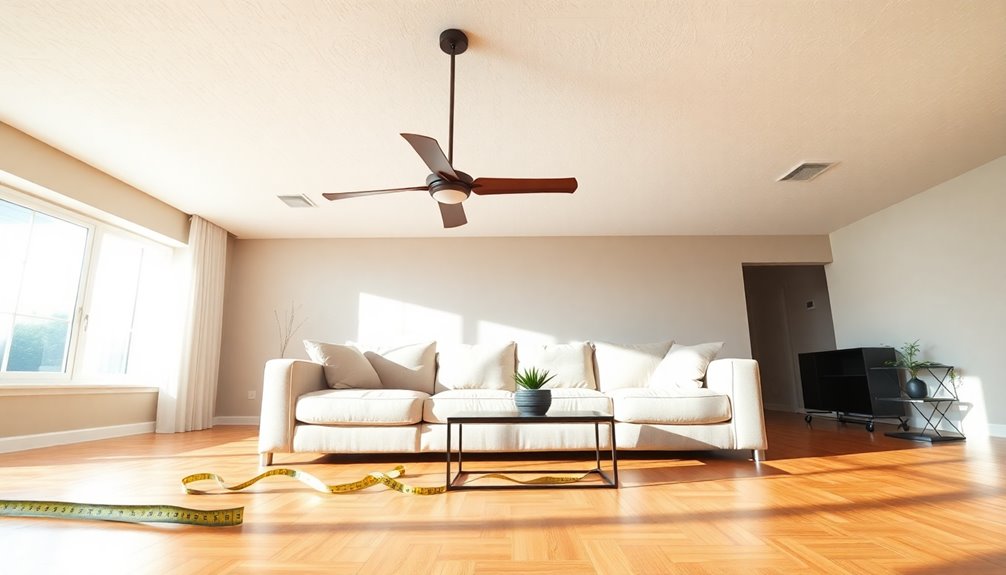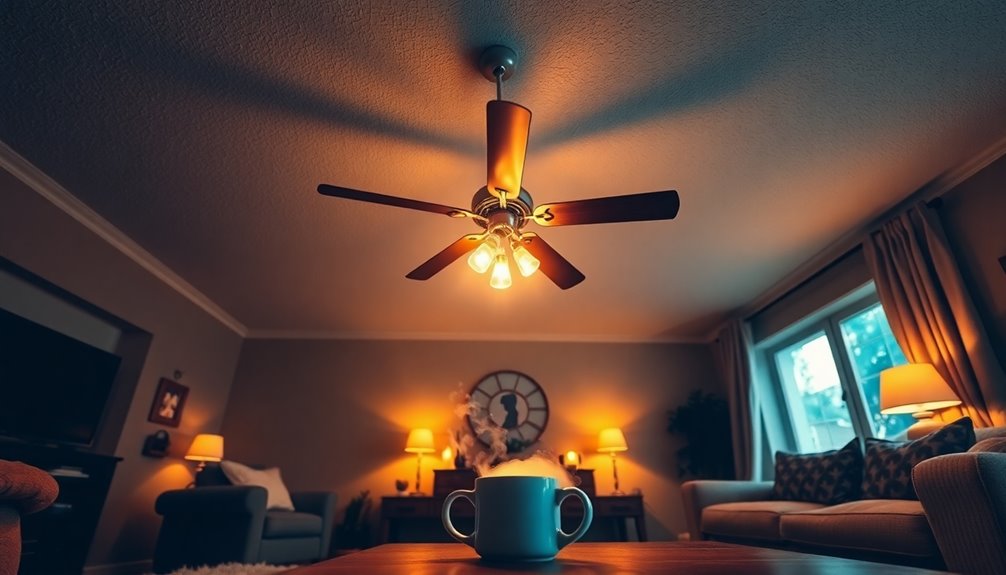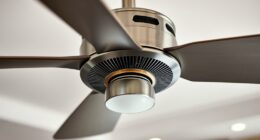Your ceiling fan should rotate counterclockwise in summer to create a cooling breeze. This direction maximizes airflow, making you feel cooler while allowing you to raise the thermostat by about 4 degrees. In winter, switch the fan to rotate clockwise at a low speed. This creates a gentle updraft, redistributing warm air evenly throughout the room. Changing the direction is easy—just make sure the fan is off. Align these changes with the seasons for optimum comfort and energy savings. If you're curious about how to maintain efficiency and adjust for different rooms, you'll find more helpful tips ahead.
Key Takeaways
- In summer, ceiling fans should rotate counterclockwise to create a cooling breeze and enhance comfort.
- In winter, fans should rotate clockwise at low speed to redistribute warm air without drafts.
- Adjust fan direction with the change of seasons, aligning with Daylight Savings Time for optimal efficiency.
- For maximum energy savings, use fans in conjunction with air conditioning or heating systems.
- Regular maintenance, such as cleaning blades, ensures fans operate efficiently in the correct direction.
Importance of Ceiling Fan Direction

The direction of your ceiling fan plays a crucial role in maintaining comfort and efficiency in your home. By adjusting the ceiling fan direction according to the seasons, you can greatly enhance your indoor environment and save on energy costs.
In summer, setting your fan to rotate counterclockwise creates a cooling downdraft, making you feel cooler without over-relying on air conditioning. This simple adjustment can lower perceived temperatures and help reduce your cooling costs by as much as 30%.
In winter, you'll want to switch the fan to spin clockwise. This creates an updraft that pushes warm air, which tends to rise and get trapped near the ceiling, back down into the living space. This can improve your heating efficiency and comfort while potentially lowering your heating costs by 15% or more.
Regularly changing your ceiling fan direction as the seasons change is essential. It not only keeps your home's temperature more consistent but also prevents your heating and cooling systems from working overtime, which can lead to unnecessary energy expenses.
Ceiling Fan Direction in Summer

In summer, you want your ceiling fan to spin counterclockwise to create a revitalizing downdraft that enhances the cooling wind chill effect.
By adjusting the fan direction, you can also save energy, potentially raising your thermostat setting by about 4 degrees without sacrificing comfort.
Don't forget to set your outdoor fans the same way to maximize cooling and keep pesky insects at bay.
Cooling Wind Chill Effect
To stay cool during the summer months, you'll want your ceiling fan rotating counterclockwise. This fan direction creates a cooling downdraft that pushes cooler air downwards, enhancing your comfort.
As the fan spins, it generates a wind chill effect, making the room feel considerably cooler even though the actual air temperature remains unchanged.
By running your ceiling fan counterclockwise at a high speed, you maximize airflow and amplify the cooling sensation. This means you can enjoy a revitalizing breeze while potentially raising your thermostat setting by about 4 degrees.
With this simple adjustment, you not only enhance your comfort but also contribute to energy savings on air conditioning costs.
The wind chill effect produced by the ceiling fan can make a noticeable difference in how you experience the heat.
By improving air circulation and efficiency, you can reduce your cooling costs by up to 30%.
Energy Savings Potential
Ceiling fans can be a game changer for your summer energy bills. By setting your ceiling fan to rotate counterclockwise, you create a invigorating downdraft that produces a wind chill effect, making the air feel cooler. This simple adjustment allows you to raise your thermostat settings by about 4 degrees, potentially reducing air conditioning costs by up to 30%.
Here's a quick comparison of energy usage:
| Appliance | Watts Used | Cost Savings Potential |
|---|---|---|
| Ceiling Fan | 50 | Up to 30% |
| Central Air Unit | 3,500 | – |
| ENERGY STAR AC Unit | Varies | Additional 8% savings |
Running a ceiling fan uses notably less energy than air conditioning units, making it a smart choice for energy efficiency. Plus, with fan blades angled at a minimum of 12 degrees, you can maximize airflow and enhance cooling efficiency, especially in larger rooms. Combining ceiling fans with ENERGY STAR certified air conditioning systems can further contribute to substantial cost savings over time. Embrace the cool air and watch your energy bills drop!
Outdoor Fan Settings
Choosing the right direction for your outdoor ceiling fans in summer can greatly enhance your comfort. You should set your outdoor ceiling fan to rotate counterclockwise in the summer. This counterclockwise motion creates a cooling downdraft that effectively pushes cooler air down, making the outdoor space feel considerably more comfortable.
When the fan runs counterclockwise, it enhances the wind chill effect for everyone beneath it, helping you beat the heat. This simple adjustment not only boosts your comfort but can also lead to energy savings by reducing your reliance on air conditioning.
Ensure that your outdoor ceiling fan is designed for outdoor use; indoor fans can suffer damage from exposure to the elements. Properly set outdoor ceiling fans improve air circulation and can reduce the perceived temperature, creating a more enjoyable atmosphere, especially during those hot summer days.
Ceiling Fan Direction in Winter

In winter, you should set your ceiling fan to rotate clockwise to create a gentle updraft that pushes warm air down into your living space.
Running the fan at a low speed guarantees even heat distribution without causing drafts.
This simple adjustment can help you save on heating bills while keeping your home cozy.
Benefits of Clockwise Rotation
One of the simplest ways to enhance your home's comfort during winter is by adjusting your ceiling fan to rotate clockwise. This setting helps pull the warm air that naturally rises to the ceiling down into your living space, creating a cozy environment. By running the fan on a low speed, you can avoid drafts while enjoying a gentle airflow that effectively redistributes heat without discomfort.
Here are some key benefits of using your ceiling fan in a clockwise direction:
| Benefit | Description | Energy Savings |
|---|---|---|
| Enhanced Warmth | Pulls warm air down into the room | Up to 15% savings |
| Eliminates Cold Spots | Promotes consistent temperature throughout | Lower thermostat settings |
| Gentle Airflow | Prevents drafts while redistributing heat | Improved comfort |
| Ideal for Vaulted Ceilings | Minimizes wind chill effects | More efficient heating |
| Cost-effective Solution | Reduces heating bills without sacrificing comfort | Budget-friendly |
Using your ceiling fan clockwise not only keeps you warm but also contributes to significant energy savings. Enjoy a more comfortable winter season by making this simple adjustment!
Optimal Fan Speed
Adjusting the speed of your ceiling fan during winter plays a significant role in maximizing its effectiveness. To achieve ideal fan speed, set your fan to rotate clockwise at a low speed. This gentle updraft helps redistribute warm air trapped near the ceiling back down into your living space.
You'll find that this clockwise motion maintains a comfortable temperature without creating cold drafts, allowing you to lower your thermostat settings and save on energy costs.
By running the fan at this ideal speed, you could reduce your utility bills by 15% or more, as it enhances heat distribution from your heating system. To confirm the fan direction is correct, stand directly under the fan and check for minimal air movement; this indicates the fan is operating as intended.
If you have a vaulted ceiling, keeping the fan in a clockwise rotation year-round helps minimize the wind chill effect while still effectively circulating warm air.
How to Change Fan Direction

Changing the direction of your ceiling fan can considerably enhance your home's comfort and energy efficiency.
To successfully change the direction, make sure the fan is off and has completely stopped. If you have a pull chain fan, look for the ceiling fan switch on the fan body. Simply toggle it to switch directions.
For remote-controlled fans, turn the fan off first, then press and hold the fan button on the remote until a light blinks, indicating the direction change worked.
If you own a smart fan, adjusting the direction is even easier. Use SIMPLEconnect® WiFi® technology or compatible voice commands through your app or device to change the direction.
Remember, during warmer months, you'll want to set the fan to turn counterclockwise to create a cooling breeze. In cooler months, switch it to turn clockwise to circulate warm air.
After you've made the adjustments, don't forget to turn the fan back on to confirm it operates in the new direction.
Following these steps will help you optimize comfort and efficiency in your living space.
Timing for Direction Change

Seasonal changes provide a perfect opportunity to adjust your ceiling fan's direction for maximum comfort and energy savings.
The best timing for direction change aligns with Daylight Savings Time adjustments in spring and fall. When springing forward, you'll want to set your fan to rotate counterclockwise. This direction helps create a cooling breeze, preparing your home for the warmer summer months.
Conversely, when falling back, switch the fan to rotate clockwise. This helps circulate warm air from the ceiling down into the living space, making your home cozier during the winter.
It's essential to take into account the size of your ceiling fan in relation to your room, as properly sized fans enhance performance during these seasonal direction changes. Additionally, using a commercial grade heat pump can further optimize your home's heating and cooling efficiency, complementing the benefits of your ceiling fan.
Ceiling Fan Direction by Room

Understanding how to adjust your ceiling fan's direction can enhance comfort in specific spaces throughout your home.
In living rooms, set your ceiling fan to spin counterclockwise during summer for a cooling breeze. When winter arrives, switch it to spin clockwise at low speed to circulate warm air without drafts.
For dining rooms, the fan should rotate clockwise at medium or low speed in winter to keep food warm, while a counterclockwise spin in the summer guarantees comfort.
In home offices, a clockwise rotation helps keep papers in place, but switch to counterclockwise in summer for a cooler environment.
In bedrooms, you'll want to spin your fan counterclockwise during the summer to promote cooling, and then switch to a clockwise direction in winter to maintain warmth without direct drafts.
Finally, outdoor fans should always rotate counterclockwise at high speed during warmer months to create an invigorating breeze and help keep insects at bay.
Energy Savings With Ceiling Fans

Ceiling fans can be a game-changer for your energy bills, especially when used correctly throughout the year. If you set your ceiling fan to spin counterclockwise in the summer, you can boost your air conditioning's cooling effect, potentially slashing your energy costs by up to 30%.
In winter, switch the fan direction to clockwise and run it at a low speed. This simple adjustment redistributes warm air without creating drafts, leading to utility bill reductions of 15% or more.
Using a ceiling fan consumes about 50 watts of energy, a fraction of the 3,500 watts that air conditioning units typically use. This makes ceiling fans a cost-effective option for cooling your home.
When you pair a ceiling fan with an ENERGY STAR-certified air conditioning unit, you can improve overall energy efficiency by up to 8%, further enhancing your energy savings.
Don't forget that regular maintenance, like cleaning the blades and ensuring proper alignment, can optimize your ceiling fan's performance.
Frequently Asked Questions
Which Way Should a Ceiling Fan Turn in the Summer?
In the summer, you want your ceiling fan to turn counterclockwise.
This rotation creates a cooling downdraft that pushes cool air down towards you, making the room feel notably cooler.
You'll enjoy a wind chill effect that can lower the perceived temperature by up to 4 degrees Fahrenheit.
Running it at high speed not only enhances comfort but can also help cut your energy costs by reducing reliance on air conditioning.
How Do You Tell if a Fan Is Going Clockwise or Counterclockwise?
To tell if a fan's going clockwise or counterclockwise, stand underneath it and observe the blade movement.
If the blades move from the top left to the bottom right, it's rotating clockwise. If they move from the top right to the left, it's counterclockwise.
You can also feel for a breeze; a cooling effect means it's counterclockwise.
If you're still unsure, use a lightweight object to confirm the airflow direction.
How Do I Know if My Ceiling Fan Is in Winter Mode?
To know if your ceiling fan is in winter mode, stand directly beneath it and feel for a gentle updraft.
If you notice that warm air is being pushed down and there's no strong breeze, it's likely in winter mode.
Check the fan's reversing switch or remote control to verify it's set to rotate clockwise.
Running it at a low speed will help maintain warmth without creating drafts in your room.
Which Way Should a Ceiling Fan Turn in Summer Reddit?
When you're trying to stay cool in summer, you want your ceiling fan to spin in a specific direction.
Set it to rotate counterclockwise. This creates an invigorating downdraft, enhancing airflow and making you feel cooler.
You'll notice the wind chill effect immediately, and it lets you raise your thermostat by a few degrees, saving energy.
Just stand underneath and feel for the airflow to confirm it's working right!
Conclusion
In the grand dance of home comfort, understanding your ceiling fan's direction can make all the difference. By simply flipping that switch, you can enjoy a rejuvenating breeze in summer or a cozy warmth in winter. Don't underestimate the power of a little adjustment; it's like inviting a gentle friend to enhance your living space. So, make those subtle changes and reap the rewards—your energy bills and comfort levels will surely thank you!









